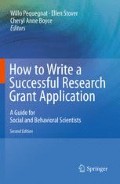Abstract
Science is all about observation with the goal of inferring relationships between variables, usually of the cause and effect variety. But the problem with observation is that it can be biased, especially when it comes to inferences of causality or even simple association. A good grant proposal must demonstrate how causal inferences will be made and, in so doing, how bias in interpretation will be reduced. Causal connections can never be determined with absolute certitude. What scientists try to do is to increase the plausibility of the explanation that variation in one variable is caused by variation is the other variable, that changes in one variable cause changes in another variable. Control groups are important in increasing confidence in causal inferences by reducing the plausibility of alternative explanations. A control group is essential to inform us if change in our dependent variable can be attributed to change in an independent variable. This chapter provides guidance on designing a control group that will meet the needs of your research design.
Access this chapter
Tax calculation will be finalised at checkout
Purchases are for personal use only
References
Aldington, S., Harwood, M. (2008). “Cannabis use and risk of lung cancer: A case-control study.” otolaryngol Head Neck Surg 138(3): 374–80
Altman, D. G., Schulz, K. F. et al. (2001). “The revised CONSORT statement for reporting randomized trials: explanation and elaboration.” Ann Intern Med 134(8): 663–94
Campbell, D. T., and J. C. Stanley (1963). Experimental and quasi-experimental designs for research. Dallas, TX, Houghton Mifflin.
Cardo, D. M., Culver, D. H. (1997). “A case-control study of HIV seroconversion in health care workers after percutaneous exposure.” N Engl J Med 337(21): 1542–3.
Clark, T. S., G. K. Friedrich, et al. (2006). “An adolescent-targeted HIV prevention project using African professional soccer players as role models and educators in Bulawayo, Zimbabwe.” AIDS Behav 10(4 Suppl): S77–83.
Cochrane, A. L. (1972). Effectiveness and efficiency: Random reflections on health services. Abingdon, UK, The Nuffield Provincial Hospitals Trust.
Cook, T. D., and Campbell, D. T. (1979). Quasi-experimentation: Design and analysis for field settings. Chicago, IL, Rand McNally.
Crosby, R. A., and Holtgrave, D. R. (2006). “The protective value of social capital against teen pregnancy: a state-level analysis” J Adolesc Health 38(5): 556–9.
DiClemente, R. J., Wingood, G. M., et al. (2004). “Efficacy of an HIV prevention intervention for African American adolscent girls: a randomized controlled trial.” JAMA 292:(2): 171–9.
Grant, R. M., Hamer, D et al. (2008). “Whither or wither microbicides?” Science 321(5888): 532–4.
Holtgrave DR, Curran JW. (2006). “What works, and what remains to be done, in HIV prevention in the United States.” Annu Rev Public Health 27: 261–75.
Jemmott, L. S., Jemmott, J. B. III, & O’Leary, A. (2007). Effects on sexual risk behavior and STD rate of brief HIV/STD prevention interventions for African American women in primary care settings. American Journal of Public Health, 97(6), 1034–1040.
Jemmott LS, Jemmott JB, Hutchinson MK, Cederbaum JA. (2008) “Sexually transmitted infection/HIV risk reduction interventions in clinical practice settings” J Obstet Gynecol Neonatal Nurs 37(2):13745.
Jemmott, J. B., III, L. S. Jemmott, et al. (1998). “Abstinence and safer sex HIV risk-reduction interventions for African American adolescents: a randomized controlled trial.” JAMA 279(19): 1529–36.
Khan, M. M., S. Mahmud, et al. (2008). “Case-control study of suicide in Karachi, Pakistan”. Br J Psychiatry 193(5): 402–5.
Khumalo-Sakutukwa, G., S. F. Morin, et al. (2008). “Project Accept (HPTN 043): a community-based intervention to reduce HIV incidence in populations at risk for HIV in sub-Saharan Africa and Thailand.” J Acquir Immune Defic Syndr 49(4): 422–31.
Koblin, B., M. Chesney, et al. (2004). “Effects of a behavioural intervention to reduce acquisition of HIV infection among men who have sex with men: the EXPLORE randomised controlled study.” Lancet 364(9428): 41–50.
Koblin, B. A., Husnik, M. J. et al (2006). “Risk factors for HIV infection among men who have sex with men.” AIDS 20(5): 731–9
Last, J.M. (2008) Case-Controlled Study. Encyclopedia of public health. New York, Springer. Meirik, O. (2008) Cohort and case-control studies. Geneva, Switzerland, Geneva Foundation for Medical Education and Research.
Moher, D., Schulz, K. F., et al. (2001). “The CONSORT statement: revised recommendations for improving the quality of reports of parallel group randomized trials.” J Am podiatr Med Assoc 91(8): 435.
NIMH Collaborative HIV/STD Prevention Trial Group. (2007). “Methodological overview of a five-country community-level HIV/sexually transmitted disease prevention trial.” AIDS 21(Suppl 2): S3–18.
Rosenbaum, P. R. (2005). Observational study. Encyclopedia of statistics in behavioral science, vol. 3. B. S. Everitt and D.C. Howell. Chichester, UK, Wiley, 1451–62.
West, S. G., N. Duan, et al. (2008). “Alternatives to the randomized controlled trial.” Am J Public Health 98(8): 1359–66.
Author information
Authors and Affiliations
Corresponding author
Editor information
Editors and Affiliations
Rights and permissions
Copyright information
© 2010 Springer Science+Business Media, LLC
About this chapter
Cite this chapter
Coates, T.J. (2010). Designing an Adequate Control Group. In: Pequegnat, W., Stover, E., Boyce, C. (eds) How to Write a Successful Research Grant Application. Springer, Boston, MA. https://doi.org/10.1007/978-1-4419-1454-5_18
Download citation
DOI: https://doi.org/10.1007/978-1-4419-1454-5_18
Published:
Publisher Name: Springer, Boston, MA
Print ISBN: 978-1-4419-1453-8
Online ISBN: 978-1-4419-1454-5
eBook Packages: MedicineMedicine (R0)

